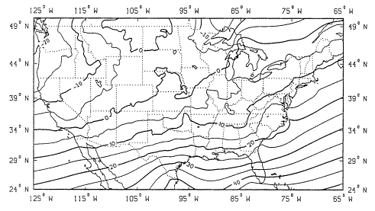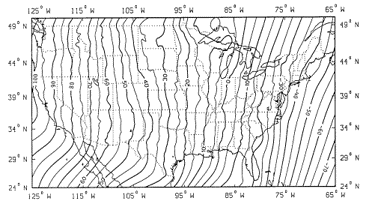2. Paradigm Shift
a. What happened in 1983?
Up though NAD 27, the Clarke 1866 ellipsoid was used and regionally fit. At time of the adjustment, the network contained approximately 25,000 control stations. Because there were two unknowns for each station (latitude and longitude), an adjustment would require solving around 50,000 simultaneous equations. Consider the state of computing technology in the late 1920s and the challenge this posed. Dr. William Bowie, Division of Geodesy chief at the time, devised a method to partitioned the data into smaller sections for adjustment. For an explanation of the Bowie Method, see Chapter 2 of NOAA NOS Professional Paper 02 "North American Datum of 1983". The document is available in the Publications section of the NGS website.
By the 1980s, the number of control stations had increased by an order of magnitude. There was pressure on two fronts to update NAD:
- Control station accuracy was based on technology available before the 1932 adjustment. The following 50 years saw the evolution of measuring platforms which achieved accuracies higher than was in the network. Better measurements had to be degraded to fit the existing control.
- Satellite based platforms along with VLBI (Very Long Baseline Interferometry) allowed networks to extend beyond regional boundaries. A redesigned and geocentric ellipsoid would be a better global model.
- Better geoid modelling was possible because of increased measurement accuracy and computing capability.
It was decided that the best approach was a redefinition (different ellipsoid and fit) and readjustment to create a new datum.
The process started in the mid 1970s with a target completion date of 1983. Paper based measurements records had to be verified and hand coded (this was before scanners) and database management systems designed from scratch. Additional fieldwork was required to strengthen network geometry or replace lower quality measurements. With 270,000 stations (540,000 simultaneous equations) it was estimated that rounding errors would be an issue even with the available state-of-the-art mainframe computers ("Prediction of Roundoff Errors", Peter Meissi, ASCM Bulletin, No. 60, Feb 1978). That the completion date was missed by only three years is understandable.
b. Ellipsoids
Table D-1 shows the ellipsoids and their defined parameters used for NAD 27 and NAD 83.
| Table D-1 NAD Ellipsoids |
|||
| Datum | Ellipsoid | Fit | Fixed parameters |
| NAD 27 | Clarke 1866 | North America | a = 6,378,206.4 m b = 6,356,583.8 m |
| NAD 83 | GRS 80 | Global | a = 6,378,137 m 1/f = 298.25722 21008 8 |
c. How much did positions change?
Figure D-6 shows the final position shifts from NAD 27 to NAD 83 for CONUS.
 |
| (a) Latitude, meters |
 |
| (b) Longitude |
| Figure D-6 Position Shifts, NAD 27 to NAD 83 “North American Datum of 1983”, Charles R. Schwartz, Editor, NOAA Professional Paper NOS 2, Dec 1989 |
In the Aleutian Islands latitude and longitude shifts were as much as -160 m.
One of the greatest challenges in NAD 83 adoption was converting NAD 27 positions without introducing unacceptable errors. The shift maps show there was no uniform latitude or longitude change between the datums. NGS developed conversion software but it was understood that, at best, they provided only mapping quality positions.